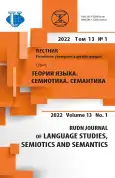Значение цвета в английских литературных произведениях
- Авторы: Карташкова Ф.И.1, Беляева Л.Е.1
-
Учреждения:
- Ивановский государственный университет
- Выпуск: Том 13, № 1 (2022)
- Страницы: 201-212
- Раздел: ЛИНГВИСТИКА ТЕКСТА
- URL: https://journal-vniispk.ru/2313-2299/article/view/323325
- DOI: https://doi.org/10.22363/2313-2299-2022-13-1-201-212
- ID: 323325
Цитировать
Полный текст
Аннотация
Статья посвящена изучению цветовой картины мира в английском художественном тексте, репрезентирующей индивидуальное представление писателя о цвете через систему цветовых значений. В настоящей статье анализу подвергаются языковые единицы, которые выражают цветоощущения, а также их влияние на характеристику персонажей и на развитие сюжета. Выявлено, что цветовая лексика представлена языковыми единицами в прямом и метафорическом значениях, а также в формате усложненного индивидуально-авторского толкования. Показано, что основной группой языковых единиц цветообозначения являются прилагательные, которые передают (либо уточняют), различные оттенки цвета, установлена их частотность, а также атрибутивные фразы с опорным компонентом, представленным именем живой/неживой природы. В качестве языковых коррелятов цвета выступают именные и глагольные компоненты. Выявлено, что цветообозначение несет особую психоэмоциональную нагрузку. Показано, что, вкупе с другими психологическими деталями значение и символика цвета, которые выполняют эстетическую функцию, могут меняться под воздействием различных факторов. Цветообозначения могут усиливать позитивную или негативную оценку объекта. Анализ фактического материала позволил дать классификацию цветовой лексики, которая включает языковые единицы в прямом, переносном и символическом значениях. На основе анализа роли света в произведениях искусства, вербализуемых в художественной литературе, доказано, что свет и транспарентная цветовая гамма передают позитивный настрой персонажей литературного произведения и вызывают у его реципиента положительные эмоции. Предпринята попытка определить установку автора на дальнейшее развитие сюжета на основе анализа используемых им цветообозначений.
Ключевые слова
Об авторах
Фаина Иосифовна Карташкова
Ивановский государственный университет
Email: kartashkova@rambler.ru
доктор филологических наук, профессор, профессор кафедры зарубежной филологии, руководитель научно-образовательного центра «Лаборатория коммуникативного поведения человека» 153025, Российская Федерация, Иваново, ул. Ермака, 39
Любовь Евгеньевна Беляева
Ивановский государственный университет
Автор, ответственный за переписку.
Email: belyalyubov@yandex.ru
аспирант, преподаватель кафедры зарубежной филологии Института гуманитарных наук 153025, Российская Федерация, Иваново, ул. Ермака, 39
Список литературы
- Novikov, L.A. (2001). Selected works. Vol. I. Problems of linguistic meaning. Vol. II. Aesthetic aspects of language. Miscellanea. Moscow: RUDN University. (In Russ.).
- Polyakova, D.N. (2005). Some features of naive and professional linguo-color pictures of the world. In: Languages of Professional Communication: Proceedings, Chelyabinsk, November 1-2, 2005. Chelyabinsk. pp. 62-67. (In Russ.).
- Soseliya, E.G. (1991). Semantic features of color designation terms. In: Historical linguistics and typology. Moscow: Nauka publ. pp. 20-25. (In Russ.).
- Perfilieva, N.V., Peihua, W., Novospasskaya, N.V. & Lazareva, O.V. (2018). Cultural Code of Color Terms in Chinese and Russian Languages. In: Wlc 2016: World Lumen Congress. Logos Universality Mentality Education Novelty (Lumen 15th Anniversary Edition). URL: https://www.europeanproceedings.com/files/data/article/104/4964/article_104_4964_pdf_100.pdf (accessed: 23.03.2021). https://doi.org/10.15405/EPSBS.2019.03.02.171
- Pasechnik, T.B. & Savelieva, I.G. (2019). What is the Colour of the Feeling (A Case Study of English Idioms with Colour Components). RUDN Journal of Language Studies, Semiotics аnd Semantics, 10(3), 714-721. https://doi.org/10.22363/2313-2299-2019-10-3-714-721 (In Russ.).
- Kulpina, V.G. (2008). Presentation in linguodidactics of color stereotypes as socio-mental categories. In: Language. Culture. Communication. Moscow. pp. 312-328. (In Russ.).
- Shelepova, N.V. (2005). Cognitive and semantic aspects of English color terms. Issuies of cognitive linguistics, 2, 72-76. (In Russ.).
- Bogdanova, I.A. (2015). Fadeless color. Moscow: Sibirskaja Blagozvonnica. (In Russ.).
- Vasilevich, A.P. (1987). The study of vocabulary in a psycholinguistic experiment: on the material of color terms in languages of different systems. Moscow: Nauka publ. (In Russ.).
- Gataullina, L.R. (2004). Review of views on color within the framework of various linguistic concepts. In: Questions of the functioning of language units. Ufa. pp. 114-122. (In Russ.).
- Komarova, Z.I. & Talapina, M.B. (2011). Linguistic color picture of the world: achromatic fragment: monograph. Ekaterinburg: the Ural Federal University named after V.I. the First President of Russia B.N. Yeltsin. (In Russ.).
- Berlin, B. & Kay, P. (1969). Basic Color Terms: their universality and evolution. Los Angeles: Berkeley.
- Frumkina, R.M. (1984). Color, meaning, similarity. Moscow. (In Russ.).
- Komova, T.A. (2000). Color terms as an object of categorization: based on Russian and English languages. In: Cognitive aspects of language categorization: collection of articles. Ryazan: RGPU them. Yesenin. pp. 76-82. (In Russ.).
- Wilde, O. (2010). The Picture of Dorian Gray. London: Collins Classics.
- Tartt, D. (2015). The Goldfinch. New York; Boston; London: Little, Brown.
- Stone, I. (2001). Lust for Life. London: Arrow Books.
Дополнительные файлы









